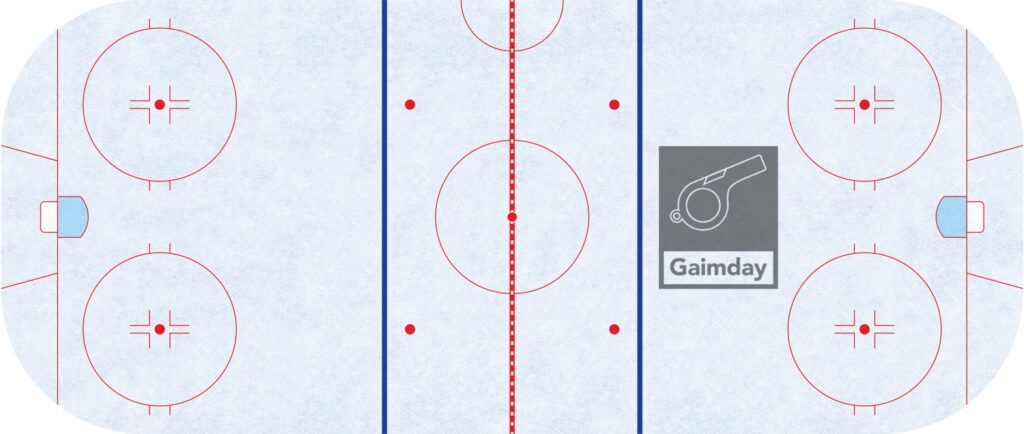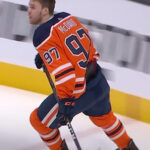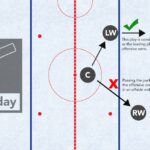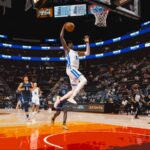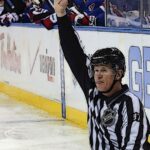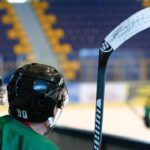Have you ever asked yourself what those markings are on the surface of an ice rink? Are there any specific lines, circles or areas that have you scratching your head?
You may have noticed shaded areas, trapezoid shapes and an odd half circle by centre ice.
What's with those dots and painted lines inside and outside of large circles?
If you're already familiar with the basics, make sure to use table of contents below to skip to a specfic section. Jump to the part that sparked your interest in the first place.
Or stick around if you want a full breakdown of these lines and the other markings with corresponding illustrations.
For starters, let's begin with an overview of the ice rink and its dimensions. We'll drill down to specific areas as you continue on.
Dimensions of Rink Surface

The standard size for an NHL rink is 200 feet long by 85 feet wide. In addition, the corners behind the net are rounded.
Both offensive and defensive zones are 75 feet long, while the neutral zone (between the blue lines) is 50 feet long.
Center Line

The center line is the line that cuts across the middle of the ice. All face-offs at the start of the period and following a goal take place along the line within the neutral zone face-off circle.
The center line also plays a role in icing. If you’re not sure what that is, we describe it below under the Goal Line sub header over here.
Basically, if you shoot the puck into the opposing team’s zone behind center line, your team is subject to getting called for an icing. The subsequent face-off would take place back in your zone.
Blue Lines

As mentioned above, the two blue lines are what delineates the neutral zone from the attacking (and/or defending) zones.
Teams cannot cross into the offensive zone without the puck entering first, a rule known as Offsides. If you’d like to learn more about this rule, make sure to check out my blog post about What is Offsides?
As a note worth mentioning, there is an interesting exception to this rule where the puck carrier can cross over the line first with the puck following behind. Again, this is explained in that blog post.
Face-off Spots

When the offside rule is broken, the play is whistled down, and the face-off is taken at the nearest face-off spot just outside the attacking zone.
Again, there are some exceptions to where the subsequent face-off is taken based on intent or lack thereof. Most often, there is no intent behind the offside play and teammates, unfortunately, enter the zone before the puck crosses over.
However, there are clear cut times when the player knowingly penetrates offside into the zone. As a result, the subsequent face-off takes place in the defensive zone of the offending team.
Face-off Circles

There are 5 distinct face-off circles on the rink surface – 4 in-zone circles and 1 neutral ice circle. The circle is 30 feet in diameter is used as a delineator for all players except the two centremen.
In short, unless you’re the designated player taking the face-off, you cannot cross into the circle prior to puck drop. Furthermore, the wingers must line up on outer perimeter of the circle.
At center ice, players skates must line up behind just behind center line on their respective side of the ice. For zone face-offs, the wingers must keep their skates behind the protruding lines on the outer perimeter of the circles. There is no rule
As for the centremen, they must keep their skates behind the horizontal line of the inverted L’s within the face-off circle. At the same time, the left and right skate have to set on the outer sides of the vertical lines.
Goal Line

The line that runs horizontally across the net is the goal line. It serves two purposes.
As expected, this is the line that separates a goal from a non-goal when it comes to the puck crossing through to the net.
A goal is deemed as such if the puck crosses the goal line entirely. Should any part of the puck remain on the goal line, it’s not considered a goal.
The other purpose of the goal line is to whistle down a play for icing. Icing is a play where a team clears the puck to the other end of the ice, behind the center line. The play is actually blown dead if a player on the defending team crosses the end zone face-off dots first and is nearest to the puck.
The ensuing face-off is taken at the opposite end of the ice, in the offending team’s zone. Furthermore, the offending team cannot make a line change prior to the face-off.
If you’d like a more detailed explanation of icing, make sure to check out my blog post about What is Icing in Hockey?
Goal Crease

The blue patch just in front of the net is known as the goal crease. Goaltenders have the right to freely move within their own goal crease. Although opposing players can skate through the crease, they cannot interfere or initiate contact with the goalie.
If a player impedes a goalie from making a save and the puck crosses the net, the goal will be called back.
Also, depending on the level of contact in the crease, a player may be called with goalie interference.
Goalkeeper’s Restricted Area (Trapezoid)

Behind the net there are two lines that form a trapezoid along with the goal line and the boards.
Goalies are only allowed to handle the puck within the trapezoid area.
Should the goaltender touch the puck anywhere else behind the goal line, they will receive a minor penalty (2-minute penalty) for a delay of game.
The trapezoid was introduced starting in the 2005-06 NHL Season, following a lockout year. Martin Brodeur (New Jersey Devils) is credited (or blamed) for the creation of the rule, namely because of his unparalleled ability to handle the puck.
The reason they limited goaltenders from playing the puck behind the net is that it impeded on offensive zone entries, such as the "dump-and-chase". Brodeur would often leave his net to play those puck dump-ins, acting like the third team defenseman.
Referee Crease

Lastly is the half circle along the center line by one side of the boards. This is known as the Referee Crease.
As the name implies, only referees (and linesmen) are allowed to gather within the crease. They usually gather to discuss a play in question or penalties called. Only team captains or alternate captains can approach the outer perimeter to speak with the referees for explanations.
